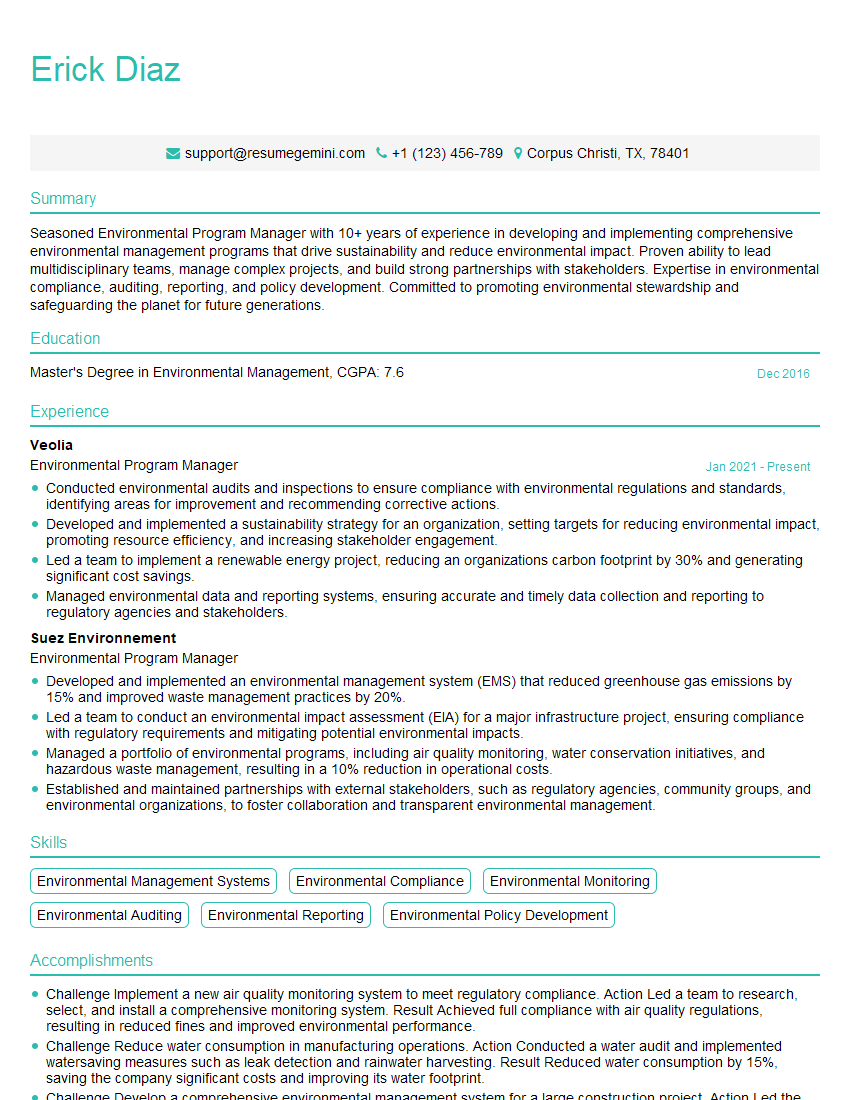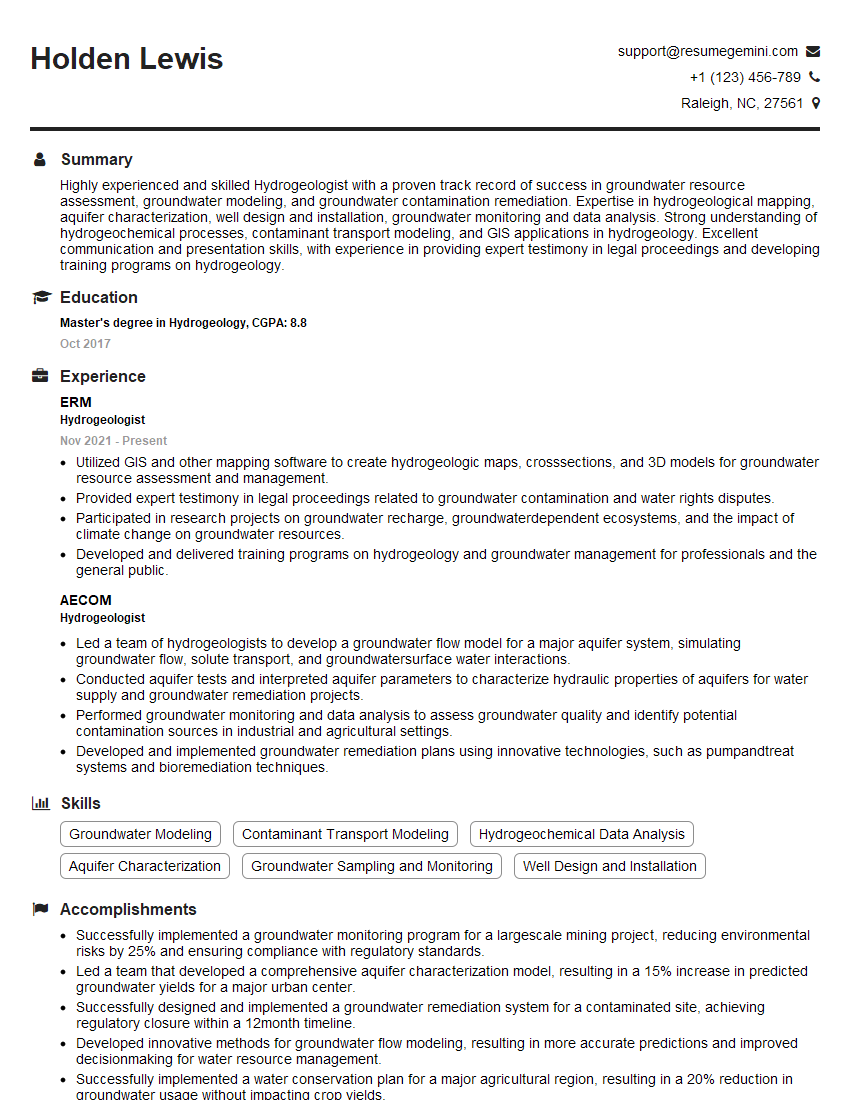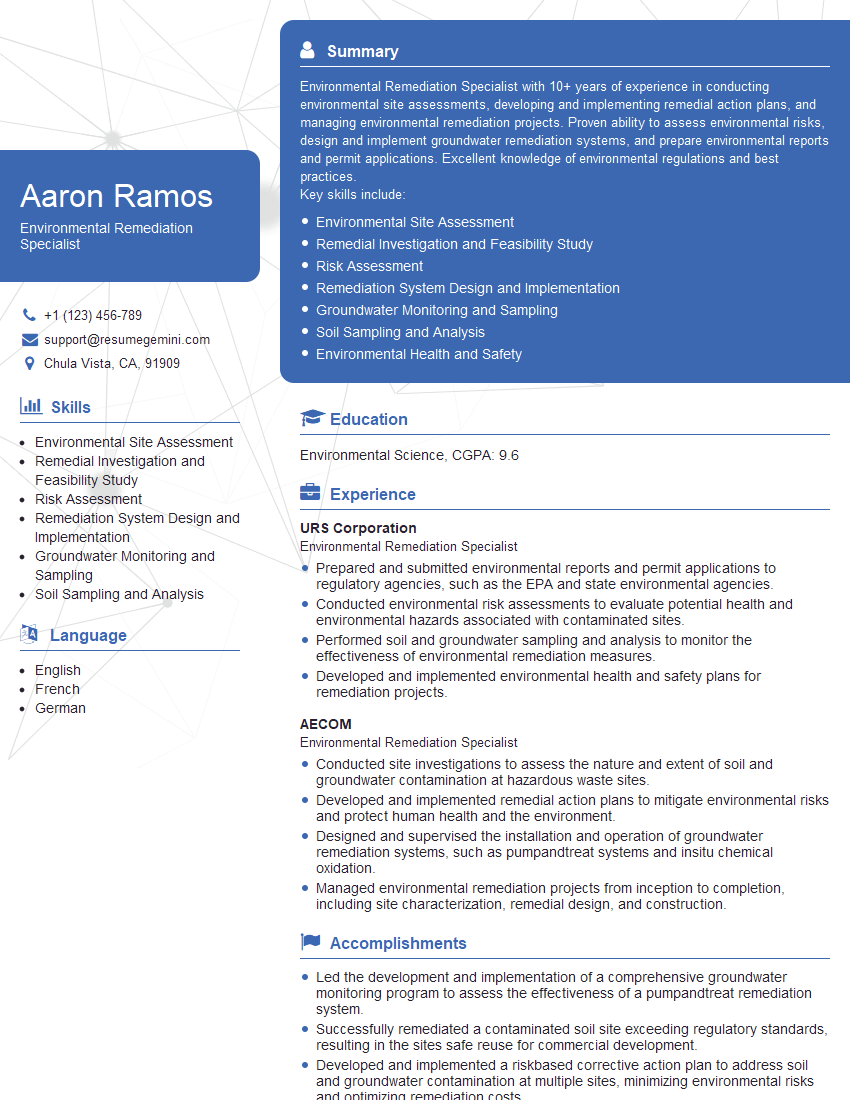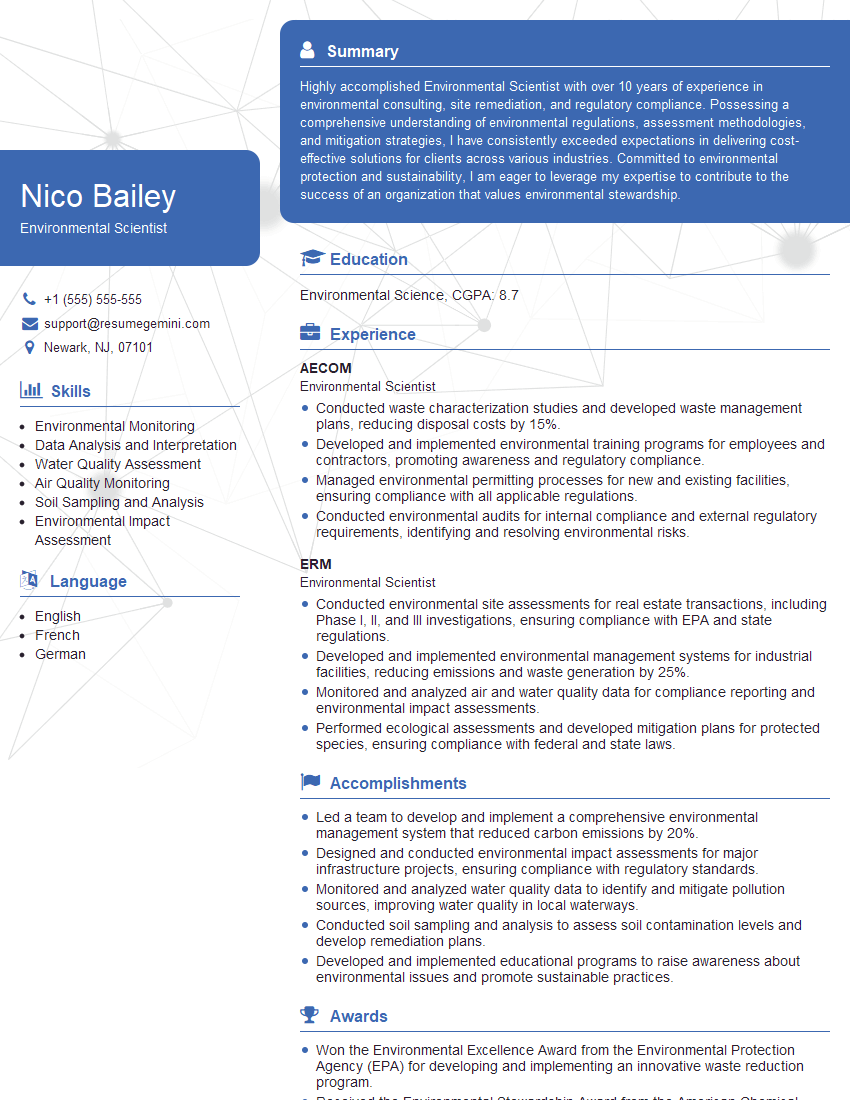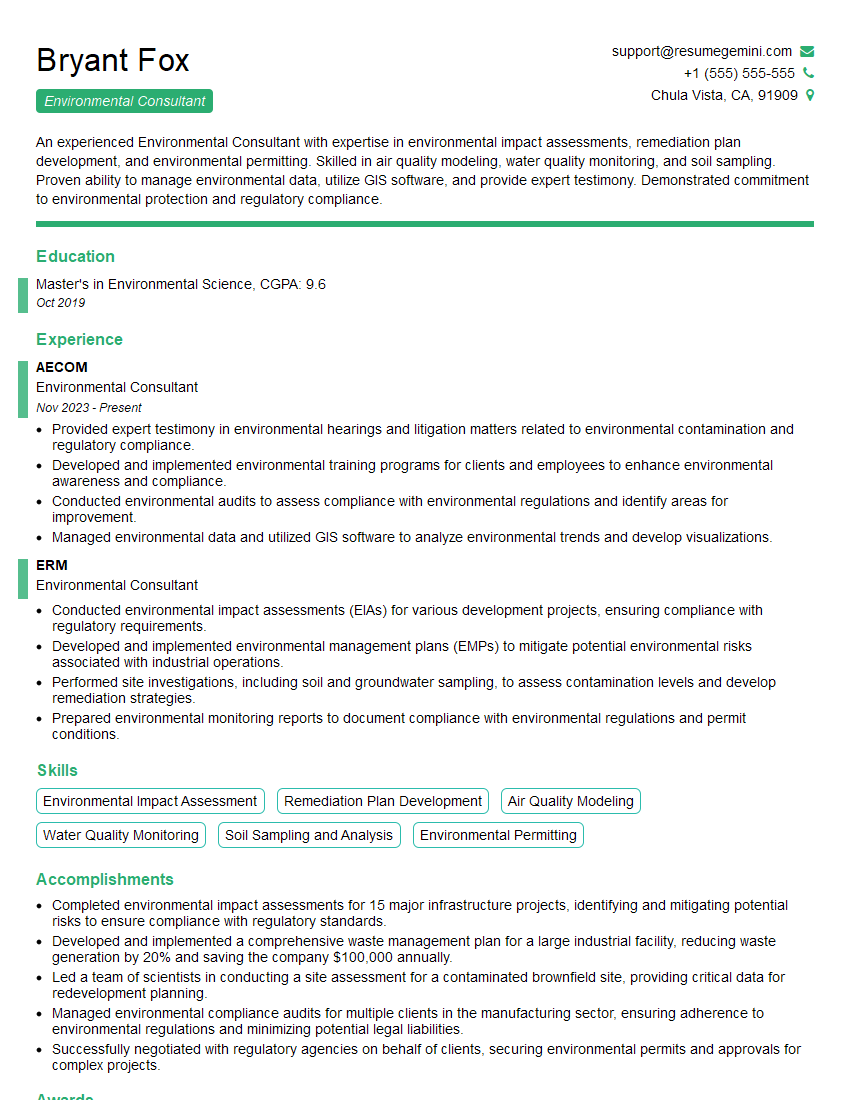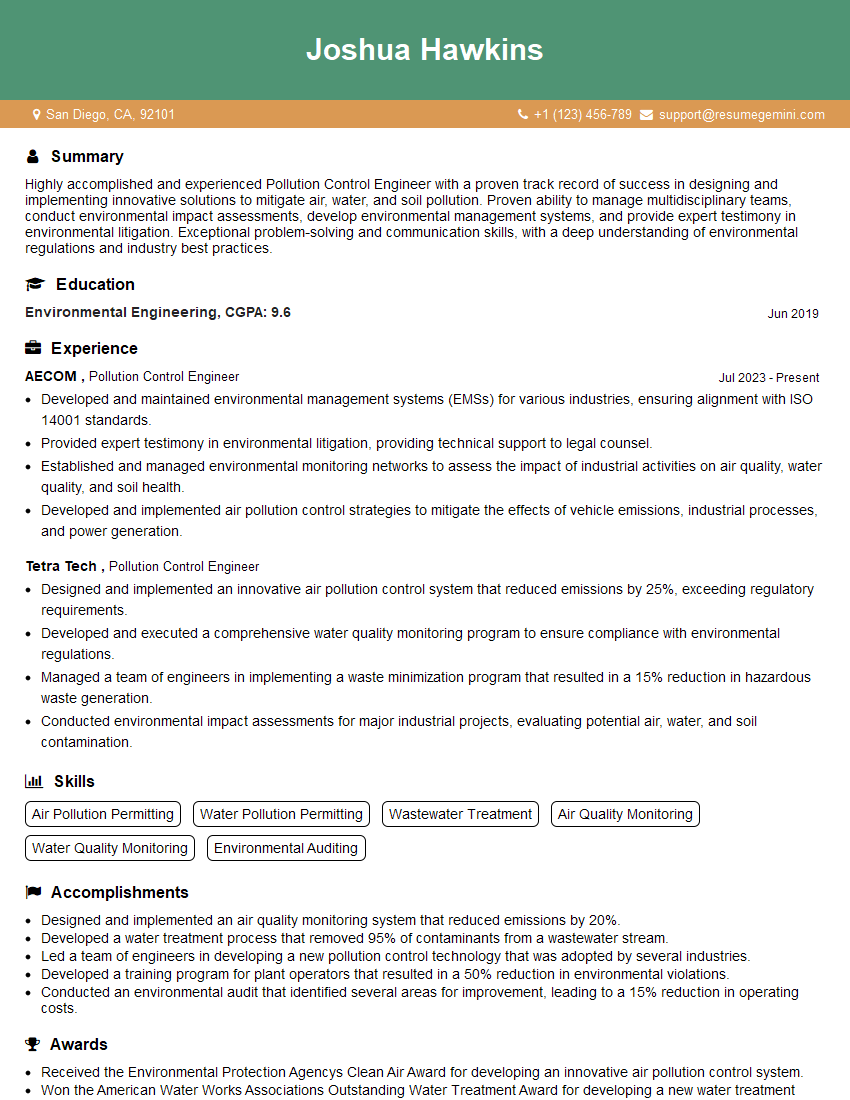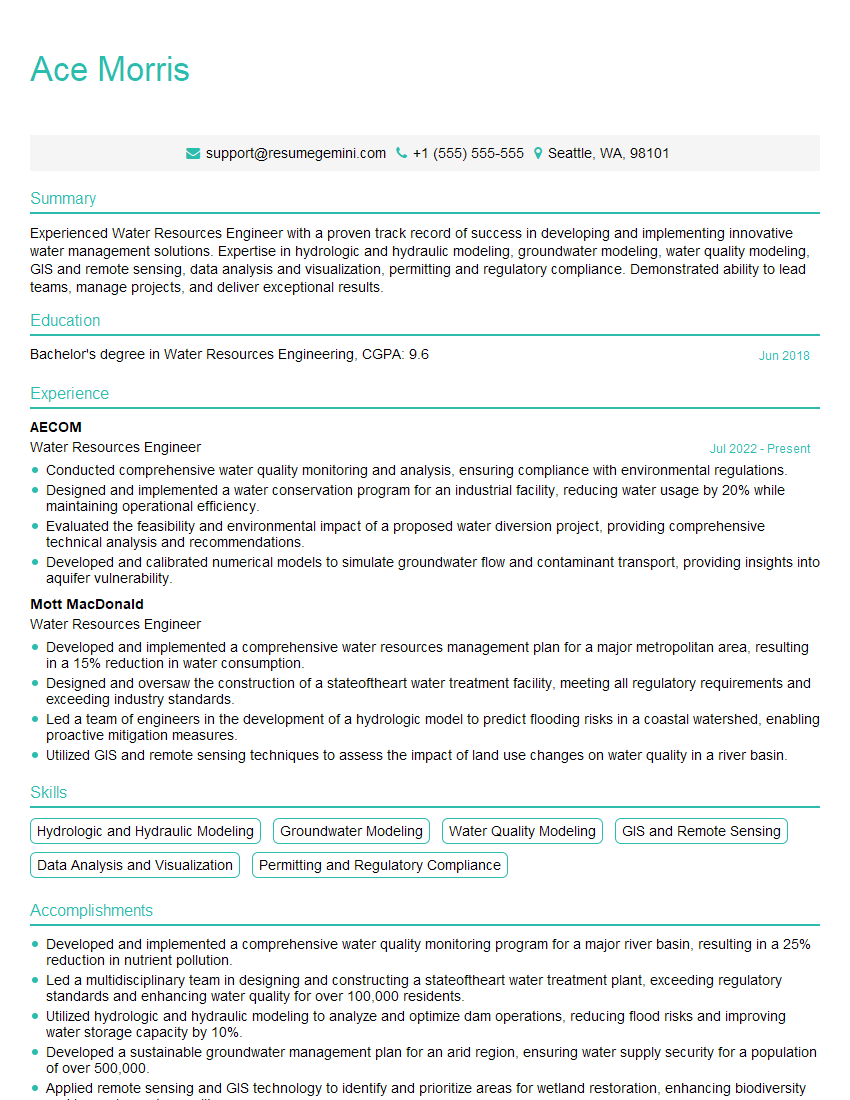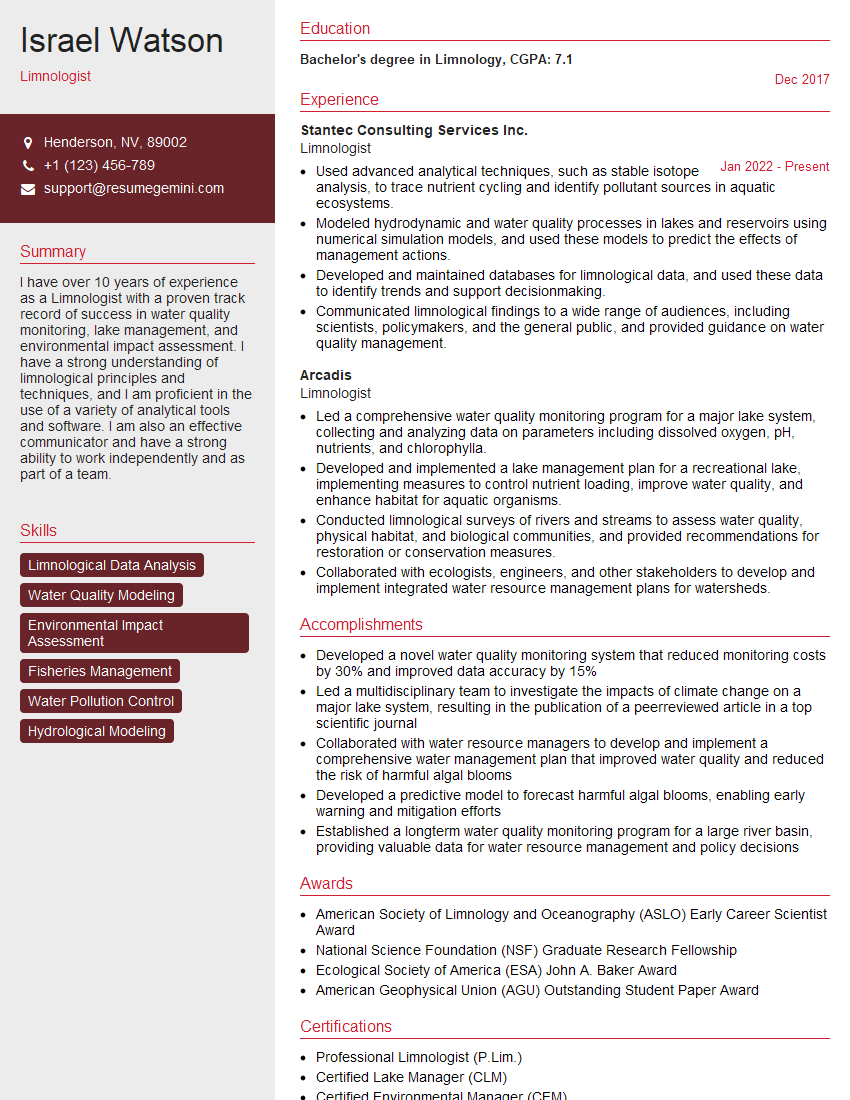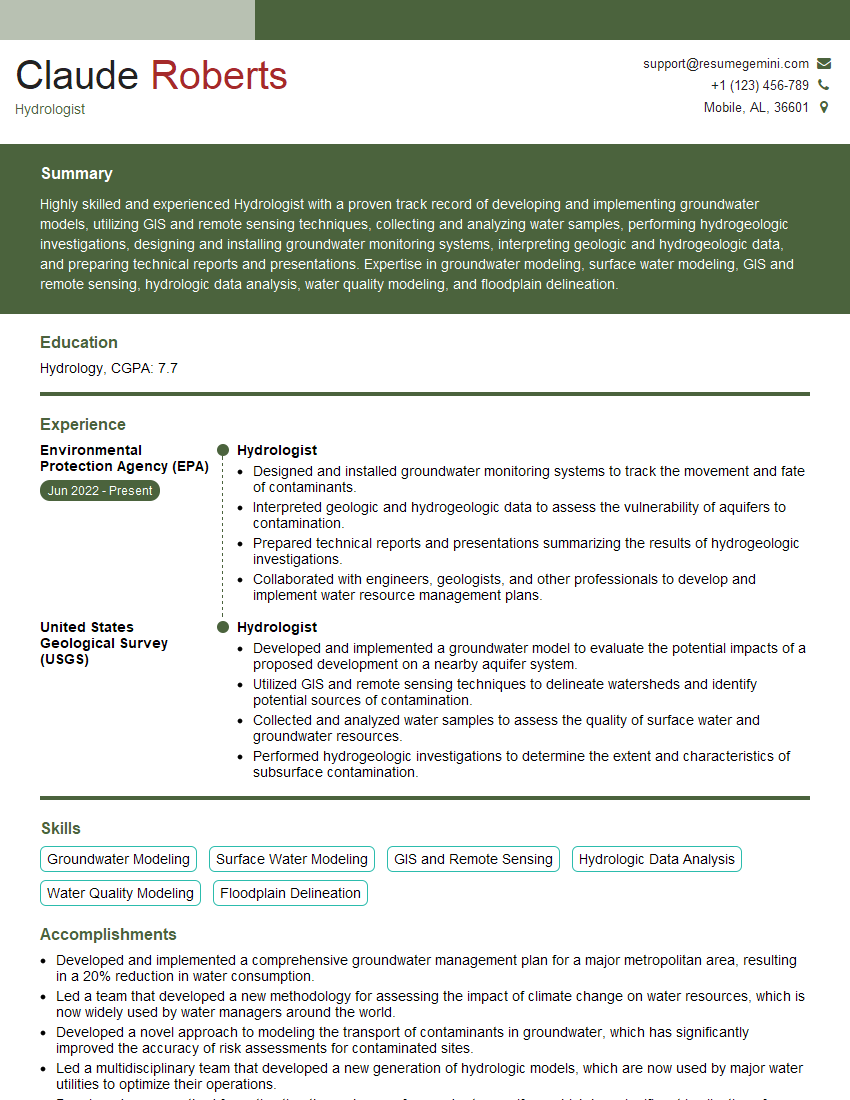The thought of an interview can be nerve-wracking, but the right preparation can make all the difference. Explore this comprehensive guide to Water Pollution Modeling interview questions and gain the confidence you need to showcase your abilities and secure the role.
Questions Asked in Water Pollution Modeling Interview
Q 1. Explain the difference between deterministic and stochastic water quality models.
The core difference between deterministic and stochastic water quality models lies in how they handle uncertainty. Deterministic models assume all parameters are known with certainty, leading to a single, predictable outcome. Think of it like a precise recipe: if you follow it exactly, you get the same result every time. In contrast, stochastic models explicitly incorporate uncertainty by using probability distributions for parameters. This reflects the reality of water quality data, which is often noisy and incomplete. Imagine baking a cake – even with the same recipe, slight variations in ingredients or oven temperature can lead to different results. Stochastic models account for this variability, providing a range of possible outcomes and associated probabilities.
For example, a deterministic model might predict a dissolved oxygen concentration of 5 mg/L downstream of a pollution source. A stochastic model, on the other hand, might predict a concentration between 4 and 6 mg/L, with a higher probability of being closer to 5 mg/L. The choice between deterministic and stochastic modeling depends on the specific application and the level of uncertainty acceptable. If high precision is crucial, and data is reliable, deterministic models might suffice. However, for situations with high variability or incomplete data, a stochastic approach is generally more realistic and provides a better representation of the system’s behavior.
Q 2. Describe the limitations of using a steady-state model versus a dynamic model.
Steady-state models assume the system is at equilibrium, meaning the inputs and outputs are balanced, and there are no significant changes over time. This simplification makes them computationally efficient but limits their ability to capture temporal dynamics. Dynamic models, conversely, explicitly account for changes over time, providing a more accurate representation of the system’s evolution. Think of a bathtub: a steady-state model only considers the water level when the inflow and outflow are equal. A dynamic model tracks the water level as it changes over time based on different inflow and outflow rates.
The limitations of steady-state models are most apparent when dealing with events like storm runoff, which cause rapid changes in water quality. Steady-state models would fail to capture the peak pollutant concentrations associated with such events. Dynamic models are essential for assessing the impact of such transient events and for predicting the long-term behavior of the system under variable conditions. They are, however, computationally more intensive.
Q 3. What are the common types of water quality models used for rivers, lakes, and estuaries?
The choice of water quality model depends heavily on the specific water body and the pollutants of interest. For rivers, commonly used models include:
- One-dimensional (1D) hydrodynamic and water quality models: These models simplify the river as a single channel, tracking water flow and pollutant transport along its length. Examples include QUAL2K and HEC-RAS.
- Two-dimensional (2D) hydrodynamic and water quality models: These consider variations in flow and water quality across the river’s width and depth. They are useful in situations with complex flow patterns.
Lakes often utilize:
- Hydrodynamic and water quality models: These can be 1D, 2D, or 3D, depending on the lake’s complexity and the desired level of detail. They often incorporate algorithms to simulate processes like stratification, mixing, and sediment-water interactions.
- Lake ecosystem models: These incorporate biological processes, such as nutrient cycling and phytoplankton growth.
Estuaries, due to their complex mixing of freshwater and saltwater, often require:
- Hydrodynamic and water quality models (often 2D or 3D): These models must account for salinity gradients, tidal influences, and complex flow patterns.
- Eutrophication models: These are particularly important in estuaries due to the frequent occurrence of algal blooms.
The selection of an appropriate model requires careful consideration of the system’s characteristics, data availability, and the specific research questions being addressed.
Q 4. How do you calibrate and validate a water quality model?
Calibration and validation are crucial steps in ensuring a water quality model’s reliability. Calibration involves adjusting model parameters to best fit observed data. This is often an iterative process, involving comparing model outputs to observed water quality data and adjusting parameters until a satisfactory match is achieved. Think of it like fine-tuning a musical instrument – you adjust the strings until it produces the desired sound. Common calibration techniques include optimization algorithms, such as the Levenberg-Marquardt method.
Validation, on the other hand, uses independent data not used in calibration to assess the model’s predictive ability. This verifies whether the calibrated model can accurately predict water quality under different conditions. A good validation shows a close match between predicted and observed values. If the model fails validation, it suggests that the model structure or parameter values need to be revised. For example, we might use data from one year for calibration and data from a subsequent year for validation.
Q 5. What are some common sources of error in water quality modeling?
Water quality modeling is inherently complex, and several factors can introduce errors:
- Data limitations: Inaccurate, incomplete, or insufficient data are major sources of error. Data scarcity is a frequent issue, especially for less-monitored pollutants or remote areas.
- Model structure simplifications: Models inevitably simplify complex natural processes. For instance, assuming uniform mixing in a river might not accurately reflect reality.
- Parameter uncertainty: Many model parameters are difficult to determine precisely, leading to uncertainty in model predictions.
- Spatial and temporal resolution: The model’s grid resolution and time step can influence the accuracy of results. Coarse resolutions might miss important details.
- Unrepresented processes: Models often omit some processes, such as the effects of specific biological interactions or complex interactions between pollutants.
Addressing these errors involves careful data collection, model selection appropriate to the system, robust uncertainty analysis, and continuous model improvement through research and validation.
Q 6. Explain the concept of model sensitivity analysis and its importance.
Model sensitivity analysis investigates how changes in model parameters affect the model’s outputs. This helps identify the most influential parameters, those that significantly impact the results. This information is invaluable for improving model accuracy and reducing uncertainty. For instance, a sensitivity analysis might reveal that the sediment settling rate has a much greater impact on pollutant concentrations than the rate of atmospheric deposition. This allows us to focus resources on improving the accuracy of sediment settling rate measurements.
The importance of sensitivity analysis cannot be overstated. It guides data collection efforts by prioritizing the parameters needing the most accurate measurements. It also helps in risk assessment by identifying the key factors that influence the potential for water quality degradation. Techniques for sensitivity analysis include one-at-a-time analysis and more advanced methods like variance-based global sensitivity analysis.
Q 7. Describe the different types of boundary conditions used in water quality models.
Boundary conditions define the values of water quality parameters at the edges of the model domain. They are essential for simulating realistic flows and pollutant transport. Common types include:
- Inflow boundary conditions: These specify the flow rate, water quality parameters (e.g., pollutant concentrations, temperature), and other properties entering the model domain. For example, we might specify the flow rate and pollutant concentration from a tributary entering a river.
- Outflow boundary conditions: These describe the conditions at the outlet of the model domain. They can be specified as open boundaries (where water flows freely out) or closed boundaries (where no flow is allowed).
- Concentration boundary conditions: These directly specify the concentration of pollutants at the boundaries. This is suitable when reliable concentration measurements are available at the boundaries.
- Flux boundary conditions: These describe the rate at which pollutants enter or leave the model domain across the boundaries.
The appropriate boundary condition type depends on the model setup, data availability, and the specifics of the system being studied. Careful selection of boundary conditions is vital for achieving accurate model results. Incorrect or unrealistic boundary conditions can lead to significant errors in predictions.
Q 8. How do you account for uncertainty in model parameters and inputs?
Uncertainty in water quality models stems from various sources: imprecise parameter estimations, incomplete data, and inherent model limitations. We address this through several techniques. One crucial method is Monte Carlo simulation, which involves running the model multiple times with parameters randomly sampled from probability distributions representing our uncertainty in their true values. This generates a range of possible outcomes, providing a measure of the model’s predictive uncertainty.
Another approach is using sensitivity analysis to identify the parameters that most strongly influence model outputs. This helps us prioritize data collection and model refinement efforts, focusing on the most critical uncertainties. For instance, if we find that sediment transport rates are the most sensitive parameter in predicting phosphorus concentrations, we invest in more accurate measurements of sediment properties and flows.
Bayesian methods offer a powerful framework for incorporating prior knowledge and updating our uncertainty as we acquire new data. This approach allows us to combine expert judgment with observational data to refine our understanding of model parameters. Imagine calibrating a model for a specific river. Using Bayesian methods allows us to combine limited field data with our prior knowledge about similar rivers, improving calibration accuracy and quantifying uncertainty more accurately.
Q 9. What are the key factors to consider when selecting a suitable water quality model for a specific application?
Selecting the right water quality model depends heavily on the specific application and available resources. Key factors include:
- Spatial scale: A simple box model might suffice for a well-mixed lake, while a complex hydrodynamic model is necessary for large river systems or estuaries.
- Temporal scale: Short-term events like spills require models capable of high temporal resolution, while long-term trends might be adequately addressed by less computationally intensive models.
- Data availability: The model’s complexity should match the available data. A sophisticated model is useless if you lack the data to calibrate and validate it.
- Computational resources: Complex models require significant computing power. This can be a limiting factor, especially for large-scale simulations.
- Specific pollutants: Different models are designed for different pollutants (e.g., nutrients, heavy metals, pathogens). The choice depends on the pollutant of concern.
- Model objectives: What are you trying to achieve with the model? Is it prediction, scenario analysis, or understanding underlying processes?
For example, simulating nutrient dynamics in a small, relatively homogenous lake might use a simple water quality model, whereas a large, complex estuary might demand a coupled hydrodynamic and water quality model like EFDC or DELFT3D.
Q 10. Discuss the role of GIS in water quality modeling.
GIS (Geographic Information Systems) plays a crucial role in water quality modeling by providing a framework for integrating, visualizing, and analyzing spatial data. It acts as a central hub for various datasets relevant to water quality, such as:
- Hydrography: River networks, lake boundaries, watershed delineations.
- Land use/land cover: Identifying sources of pollution (agriculture, urban areas).
- Soil properties: Influencing runoff and nutrient transport.
- Point and non-point source pollution locations: Factories, sewage treatment plants, agricultural fields.
- Monitoring stations: Locations of water quality measurements.
GIS enables the efficient preparation of input data for water quality models, often through geoprocessing tools that automate tasks like data extraction, interpolation, and raster to vector conversion. It also facilitates model visualization and result interpretation by overlaying model outputs (e.g., pollutant concentrations) onto geographical maps. This allows for easier communication of results to stakeholders and decision-makers.
Q 11. How do you incorporate spatial data into water quality models?
Spatial data is incorporated into water quality models in various ways. One common approach is to use a grid-based representation of the study area. The model divides the area into a network of cells or grid squares, and water quality variables are calculated for each cell. The size of the grid cells needs careful consideration; too large and spatial variability is lost, too small and computational demands explode. GIS assists in creating this grid and defining boundary conditions.
Spatial interpolation techniques are often used to estimate values at ungauged locations from a limited number of monitoring points. Kriging, inverse distance weighting (IDW), and other methods are used to fill in data gaps. GIS provides the tools to perform these interpolations and visualize the results.
For more complex models, GIS plays a vital role in defining network-based models. River networks are represented as interconnected segments, allowing for the simulation of pollutant transport along the river system. GIS tools are essential for building the network topology and assigning relevant parameters (e.g., streamflow, reach length) to each segment.
Q 12. Explain the application of remote sensing data in water quality assessments.
Remote sensing, using satellite or airborne sensors, provides valuable data for water quality assessment, offering synoptic views that are impossible to obtain using traditional field methods. Sensors can measure various parameters related to water quality, including:
- Water clarity (turbidity): Measured from the reflectance of light in the water column.
- Chlorophyll-a concentration (algae): Indicative of eutrophication.
- Suspended sediment concentration: Affecting water clarity and habitat.
- Water temperature: Important for biological processes.
For example, Landsat or Sentinel imagery can provide large-scale maps of chlorophyll-a concentration, which is critical for managing harmful algal blooms. These remotely sensed data are often incorporated into water quality models as either input parameters (e.g., initial conditions, boundary conditions) or validation data for model calibration. Data fusion techniques, where data from multiple sensors are combined, are often used to improve the accuracy of water quality estimates.
However, it’s important to note that remote sensing data needs careful processing and calibration to ensure accuracy. Atmospheric effects, cloud cover, and variations in sensor sensitivity can affect the quality of the derived water quality parameters.
Q 13. Describe the process of model development, including data collection, model selection, calibration, and validation.
Model development is an iterative process involving several key stages:
- Data collection: This involves gathering data on water quality parameters (e.g., temperature, dissolved oxygen, nutrient concentrations), hydrological variables (e.g., flow rate, rainfall), and other relevant factors (e.g., land use, point sources). This might involve field sampling, laboratory analysis, and data from existing databases.
- Model selection: Choosing the right model involves considering factors discussed earlier, balancing complexity with data availability and computational resources. This stage might involve comparing different models and their suitability for the specific problem.
- Model calibration: This crucial step involves adjusting the model’s parameters to best match observed data. This is often done using optimization algorithms that minimize the difference between modeled and observed values. Various techniques, like least squares, can be used.
- Model validation: This involves testing the calibrated model’s performance against an independent dataset that was not used during calibration. This ensures the model’s ability to generalize and predict accurately on unseen data. Statistical measures like RMSE (Root Mean Squared Error) and R-squared are used to assess model performance.
- Model sensitivity analysis: Determining which parameters most significantly impact model outcomes, guiding future data collection and model refinements.
If the model doesn’t perform adequately during validation, the process often loops back to model selection, parameterization, or data collection to refine the model. This iterative nature is essential for ensuring a reliable and accurate model.
Q 14. How do you interpret model results and communicate findings to non-technical audiences?
Interpreting model results requires a thorough understanding of the model’s limitations and uncertainties. This often involves assessing the range of possible outcomes based on the uncertainty analysis. It also requires comparing modeled results with observed data, identifying areas of agreement and disagreement.
Communicating these findings to non-technical audiences requires careful simplification and visualization. Avoid jargon and technical terms wherever possible. Instead, use clear language and visual aids such as maps, charts, and graphs to illustrate key results. For example, instead of saying ‘the model predicts a mean increase of 0.5 mg/L in total phosphorus concentration during the summer months with a 95% confidence interval of 0.3 to 0.7 mg/L’, you might say: ‘Our analysis suggests that phosphorus levels in the lake will likely rise during the summer, potentially leading to harmful algae blooms. This prediction has some uncertainty, but we are fairly confident the increase will be within a specific range.’
A narrative approach, storytelling with visuals, can make technical findings more accessible and engaging. It’s also crucial to highlight the implications of the findings and potential management actions to address the identified water quality issues.
Q 15. What are some common water quality parameters used in modeling?
Water quality modeling relies on numerous parameters to accurately represent the state of a water body. These parameters can be broadly categorized into physical, chemical, and biological indicators.
- Physical parameters: These describe the physical characteristics of the water, such as temperature, turbidity (cloudiness), dissolved oxygen (DO), pH (acidity/alkalinity), and water flow (discharge). For example, high turbidity can indicate sediment pollution and impact light penetration crucial for aquatic life.
- Chemical parameters: These focus on the chemical composition of the water, including nutrients (nitrogen and phosphorus – key indicators of eutrophication), heavy metals (lead, mercury, etc.), pesticides, and salinity. High nutrient levels, for instance, can lead to algal blooms, depleting oxygen and harming aquatic ecosystems.
- Biological parameters: These assess the biological community within the water body, such as the presence and abundance of specific indicator species (e.g., certain types of algae or invertebrates sensitive to pollution), bacterial counts (e.g., E. coli indicating fecal contamination), and biochemical oxygen demand (BOD) – measuring the amount of oxygen consumed by microorganisms decomposing organic matter.
The specific parameters used in a model depend heavily on the pollutants of concern and the objectives of the study.
Career Expert Tips:
- Ace those interviews! Prepare effectively by reviewing the Top 50 Most Common Interview Questions on ResumeGemini.
- Navigate your job search with confidence! Explore a wide range of Career Tips on ResumeGemini. Learn about common challenges and recommendations to overcome them.
- Craft the perfect resume! Master the Art of Resume Writing with ResumeGemini’s guide. Showcase your unique qualifications and achievements effectively.
- Don’t miss out on holiday savings! Build your dream resume with ResumeGemini’s ATS optimized templates.
Q 16. Explain the concept of water quality criteria and standards.
Water quality criteria and standards are essential for managing and protecting water resources. They define acceptable levels of pollutants in water, safeguarding human health and the environment.
- Water quality criteria are scientifically derived guidelines that describe the levels of pollutants below which adverse effects on aquatic life or human health are unlikely to occur. These are usually based on extensive research and toxicity studies.
- Water quality standards are legally mandated limits on pollutant concentrations. They are often based on water quality criteria but may incorporate additional considerations such as technological feasibility and economic impacts. These are enforced by regulatory agencies.
For example, the U.S. Environmental Protection Agency (EPA) sets water quality standards for various pollutants, while different states may have their own more stringent standards. Compliance with these standards is crucial for industries discharging wastewater and is regularly monitored.
Q 17. How do you model the transport and fate of pollutants in the environment?
Modeling the transport and fate of pollutants involves simulating how pollutants move and change within a water body or watershed. This typically employs mathematical equations that describe various processes like advection, dispersion, and reactions.
The models often incorporate:
- Hydrodynamic models: These simulate water flow patterns, determining how pollutants are transported by the movement of water.
- Transport equations: These describe the advection and dispersion of pollutants, essentially showing how pollutants move with the water and spread out.
- Reaction kinetics: These simulate chemical and biological transformations of pollutants (e.g., decay, degradation, or transformation into other compounds).
- Boundary conditions: These define the inputs (e.g., pollutant loading from point and non-point sources) and outputs (e.g., outflow from the water body) of the system.
The model outputs typically include pollutant concentrations at different locations and times, enabling predictions of water quality.
Popular software packages for water quality modeling include QUAL2K, MIKE 11, and HEC-RAS.
Q 18. Describe different pollutant transport mechanisms (advection, dispersion, etc.).
Pollutant transport is a complex process driven by several mechanisms:
- Advection: This refers to the transport of pollutants with the bulk movement of water. Think of it like being carried along by a river current – the pollutant moves in the same direction and at the same speed as the water.
- Dispersion: This represents the spreading of pollutants due to turbulent mixing within the water body. Imagine dropping a dye into a flowing stream; it initially forms a concentrated patch but gradually spreads out due to mixing. This involves both longitudinal (along the flow direction) and transverse (perpendicular to the flow) dispersion.
- Diffusion: Similar to dispersion, diffusion refers to the spreading of pollutants due to molecular movement from areas of high concentration to low concentration. This process is generally slower than dispersion but becomes significant at smaller scales.
- Sedimentation/Resuspension: Some pollutants may settle out of the water column into sediments (sedimentation) and can later be re-introduced into the water column (resuspension), influenced by factors like flow velocity and sediment characteristics.
These mechanisms act concurrently, making pollutant transport a complex process that requires sophisticated mathematical models to simulate accurately.
Q 19. How do you model the impact of point and non-point source pollution?
Point and non-point sources differ significantly in how they are modeled:
- Point source pollution: This involves pollutants entering the water body from a specific, identifiable location, such as a wastewater treatment plant discharge pipe or an industrial outfall. These are relatively easy to model because the location and discharge rate are known. The model incorporates these as boundary conditions, specifying the location and magnitude of the pollutant input.
- Non-point source pollution: This arises from diffuse sources over a larger area, such as agricultural runoff, urban stormwater, or atmospheric deposition. These are much more challenging to model because the sources are spatially distributed and difficult to quantify accurately. Models often use techniques like GIS data to incorporate land use information, rainfall patterns, and soil characteristics to estimate pollutant loadings from these diffuse sources.
Both types of sources are critical in water quality modeling and often require different data collection and modeling approaches.
Q 20. Explain the use of water quality models in environmental impact assessments.
Water quality models are indispensable in environmental impact assessments (EIAs). They allow us to predict the potential impacts of development projects or policy changes on water quality.
In an EIA, a model might be used to:
- Assess the impact of a proposed wastewater treatment plant: The model can simulate the effluent discharge and predict its effect on downstream water quality, ensuring that the plant’s discharge meets regulatory standards and minimizes environmental impacts.
- Evaluate the effectiveness of proposed pollution control measures: The model can be used to compare different scenarios (e.g., with and without a new wastewater treatment plant or with different levels of pollution control) to determine the most effective strategy.
- Predict the impacts of climate change on water quality: Models can incorporate projected changes in rainfall patterns, temperature, and flow regimes to assess how these factors may affect water quality in the future.
The model results provide crucial information for decision-makers, allowing them to make informed choices about project design and mitigation strategies to minimize negative environmental consequences.
Q 21. How do you use water quality models to support decision-making in water resource management?
Water quality models are invaluable tools for supporting decision-making in water resource management. They provide insights into the complex interactions between human activities and water quality, enabling more effective management strategies.
Examples of their use include:
- TMDL development (Total Maximum Daily Load): Models are used to determine the maximum amount of a pollutant that a water body can receive and still meet water quality standards. This information is crucial for setting pollution reduction targets for point and non-point sources.
- Reservoir operation optimization: Models can be used to optimize reservoir release strategies to maintain adequate water quality downstream, balancing water supply needs with environmental protection goals.
- Developing water quality monitoring strategies: Models help identify critical areas or parameters needing close monitoring, optimizing resource allocation for monitoring efforts.
- Evaluating the effectiveness of restoration projects: Models can be used before and after a restoration project to assess its impact on water quality, ensuring the investment is successful.
By providing quantitative predictions and scenario analyses, water quality models empower water resource managers to make data-driven decisions leading to more sustainable and effective water resource management.
Q 22. Discuss the role of water quality modeling in regulatory compliance.
Water quality modeling plays a crucial role in regulatory compliance by providing a scientific basis for assessing the impact of human activities on water bodies and ensuring that these activities adhere to established standards. Agencies like the EPA rely heavily on these models to evaluate permit applications for wastewater discharges, assess the effectiveness of pollution control measures, and establish Total Maximum Daily Loads (TMDLs) – the maximum amount of a pollutant a water body can receive and still meet water quality standards. For instance, a model might predict the concentration of a pollutant downstream of a proposed industrial discharge, allowing regulators to determine if the discharge will violate water quality criteria. If the model predicts exceedances, further mitigation measures are required before the permit is granted.
Essentially, the models serve as a bridge between scientific understanding and regulatory decision-making, offering a quantitative and predictive tool for enforcing environmental regulations and protecting water resources.
Q 23. What are the ethical considerations in water quality modeling and reporting?
Ethical considerations in water quality modeling and reporting are paramount. Transparency is key; all assumptions, limitations, and data sources used in the model must be clearly documented and accessible to stakeholders. This includes acknowledging uncertainties inherent in the modeling process, as no model perfectly replicates reality. It’s crucial to avoid bias in model selection, parameterization, and data interpretation – consciously choosing the model best suited for the specific problem, rather than one that conveniently supports a predetermined outcome.
Furthermore, reporting results accurately and honestly, even when findings are unfavorable to a client or project, is essential. Presenting incomplete or misleading information compromises the integrity of the scientific process and can have serious environmental and societal consequences. Responsible modellers prioritize scientific rigor and the accurate representation of information above other considerations.
Q 24. What software packages are you familiar with for water quality modeling?
My experience encompasses a range of water quality modeling software packages. I’m proficient in using QUAL2K, a widely-used one-dimensional model for simulating stream water quality; EFDC, a sophisticated three-dimensional hydrodynamic and water quality model useful for complex systems like estuaries and reservoirs; and MIKE 11, another powerful hydrodynamic and water quality model often employed for larger scale river systems or coastal environments. I’m also familiar with simpler, spreadsheet-based models for specific applications and have experience using GIS software (such as ArcGIS) to integrate spatial data with model outputs. The choice of software depends critically on the specific problem, the available data, and the desired level of detail.
Q 25. Describe your experience with data analysis techniques used in water quality modeling.
Data analysis is the cornerstone of effective water quality modeling. My experience involves a range of techniques, including:
- Exploratory Data Analysis (EDA): This involves visualizing data (histograms, scatter plots, box plots) to identify patterns, outliers, and potential data quality issues. For example, identifying spurious data points that could skew results.
- Time series analysis: Analyzing water quality data collected over time to identify trends, seasonality, and correlations between different parameters. This might involve using techniques like autocorrelation and moving averages to understand temporal dynamics.
- Statistical regression: Developing relationships between water quality parameters and potential stressors. For example, relating nutrient concentrations to land use patterns using multiple regression.
- Data quality control and assurance (QC/QA): Rigorous procedures are applied to ensure data accuracy and reliability, including outlier detection and removal, and assessment of data completeness.
These techniques are vital for pre-processing data to fit the model requirements and interpreting the model results.
Q 26. Explain your understanding of different numerical methods used in water quality modeling.
Water quality models employ various numerical methods to solve the governing equations that describe water flow and pollutant transport. Common methods include:
- Finite difference methods: These methods approximate the derivatives in the governing equations using difference quotients at discrete points in space and time. They are relatively simple to implement but can be less accurate for complex geometries.
- Finite element methods: These methods divide the model domain into smaller elements and solve the equations within each element, providing better accuracy and flexibility for complex geometries and boundary conditions.
- Finite volume methods: These methods conserve mass and other properties more accurately than finite difference methods, making them particularly suitable for advection-dominated problems (e.g., pollutant transport in rivers).
The choice of numerical method depends on factors like model complexity, computational resources, and the desired level of accuracy. Understanding the strengths and weaknesses of each method is vital for selecting the most appropriate approach for a given project.
Q 27. How do you manage large datasets used in water quality modeling?
Managing large datasets in water quality modeling requires efficient data management strategies. This commonly involves:
- Database management systems (DBMS): Utilizing relational databases (e.g., PostgreSQL, MySQL) or specialized environmental databases to store, organize, and retrieve large datasets efficiently.
- Data preprocessing and cleaning: Implementing automated scripts (e.g., using Python with libraries like Pandas) to clean, standardize, and prepare data for modeling. This can involve handling missing values, dealing with outliers, and transforming data into suitable formats.
- Data compression techniques: Employing compression algorithms to reduce storage space and improve data transfer speeds. For large spatio-temporal datasets, techniques like NetCDF are often employed.
- Parallel computing: Using parallel processing capabilities to speed up computationally intensive tasks, particularly for large-scale simulations.
Proper data management ensures the integrity, accessibility, and efficiency of the modeling process.
Q 28. Describe a challenging water quality modeling project and how you overcame the challenges.
One challenging project involved modeling the impact of agricultural runoff on a coastal estuary. The challenge stemmed from the highly variable nature of rainfall, the complex hydrodynamics of the estuary, and the limited availability of high-quality water quality data. We overcame these challenges by implementing the following:
- Developing a coupled hydrodynamic and water quality model: Using EFDC to simulate both the physical processes (tides, currents, salinity) and the biogeochemical processes (nutrient cycling, phytoplankton growth). This allowed us to account for the complex interactions between the physical and biological processes in the estuary.
- Utilizing statistical downscaling of rainfall data: Since long-term, high-resolution rainfall data were unavailable, we employed statistical downscaling methods to generate a realistic rainfall time series for the model’s input.
- Implementing a Bayesian calibration approach: To account for uncertainty in model parameters and data, we utilized a Bayesian approach for model calibration. This enabled us to quantify the uncertainty in model predictions and assess the sensitivity of the results to different parameters.
- Close collaboration with stakeholders: Working closely with local agencies and farmers ensured that the model was tailored to address specific management concerns and that the results were readily understood and accepted.
The project successfully provided valuable insights into the sources and impacts of agricultural runoff, guiding the development of effective water quality management strategies for the estuary.
Key Topics to Learn for Water Pollution Modeling Interview
- Hydrological Processes: Understanding rainfall-runoff, infiltration, evapotranspiration, and their impact on pollutant transport.
- Water Quality Parameters: Familiarize yourself with key parameters like BOD, COD, DO, nutrients (nitrogen and phosphorus), and heavy metals, and their measurement techniques.
- Pollutant Transport Mechanisms: Master advection, dispersion, and reaction processes governing pollutant fate and transport in various water bodies.
- Modeling Software and Techniques: Gain proficiency in at least one water quality modeling software (e.g., MIKE 11, QUAL2K, EFDC) and understand different modeling approaches (e.g., 1D, 2D, 3D models).
- Calibration and Validation: Learn the crucial steps involved in calibrating and validating models using observed data and understanding the limitations of model predictions.
- Data Analysis and Interpretation: Develop skills in analyzing hydrological and water quality data, identifying trends, and interpreting model results.
- Scenario Analysis and Sensitivity Analysis: Understand how to use models to assess the impacts of different management scenarios and evaluate the sensitivity of model outputs to input parameters.
- Practical Applications: Be prepared to discuss real-world applications of water pollution modeling, such as assessing the impact of wastewater discharge, designing remediation strategies, or evaluating the effectiveness of pollution control measures.
- Problem-Solving Approaches: Practice formulating and solving water pollution problems using a systematic approach, including defining the problem, selecting appropriate modeling tools, analyzing results, and communicating findings effectively.
Next Steps
Mastering water pollution modeling opens doors to exciting and impactful careers in environmental consulting, regulatory agencies, research institutions, and more. To significantly enhance your job prospects, it’s crucial to present your skills and experience effectively. Creating an ATS-friendly resume is key in getting your application noticed. We highly recommend using ResumeGemini to build a professional and impactful resume that highlights your expertise in water pollution modeling. ResumeGemini provides examples of resumes tailored specifically to this field, ensuring your application stands out from the competition.
Explore more articles
Users Rating of Our Blogs
Share Your Experience
We value your feedback! Please rate our content and share your thoughts (optional).
What Readers Say About Our Blog
Hi, I have something for you and recorded a quick Loom video to show the kind of value I can bring to you.
Even if we don’t work together, I’m confident you’ll take away something valuable and learn a few new ideas.
Here’s the link: https://bit.ly/loom-video-daniel
Would love your thoughts after watching!
– Daniel
This was kind of a unique content I found around the specialized skills. Very helpful questions and good detailed answers.
Very Helpful blog, thank you Interviewgemini team.
